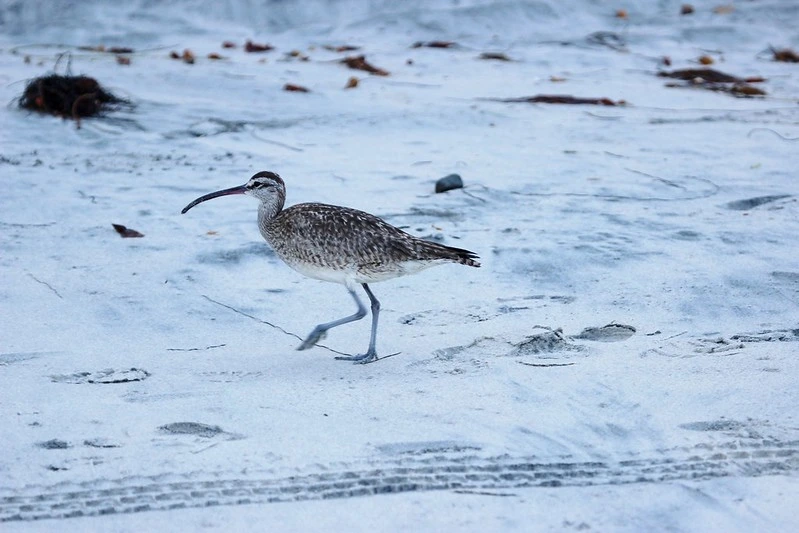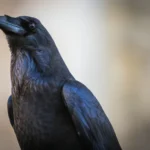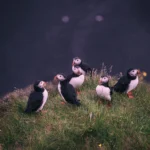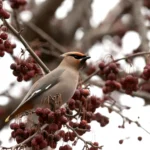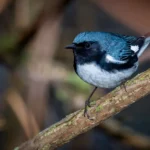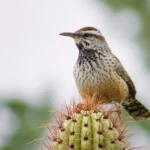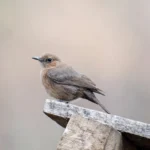Florida’s extensive coastline, estuaries, and marshlands create an ideal habitat for a variety of shorebirds. These birds not only contribute to the delicate ecosystem but also offer a fascinating subject for birdwatchers and nature enthusiasts. Whether you’re an avid birder or a casual observer, being able to recognize these species can greatly enhance your appreciation of Florida’s avian diversity. Below is a guide to some of the most commonly seen Shorebirds of Florida in the Sunshine State.
Shorebirds of florida
1. Willet (Tringa semipalmata)
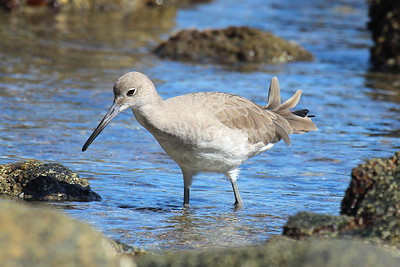
Identification: A medium-sized shorebird (13-16 inches) with a sturdy build, straight thick bill, and long grayish legs. In the non-breeding season, it has a plain gray-brown appearance, while the breeding plumage is mottled brown.
Distinctive Markings: Displays a bold black-and-white wing pattern when in flight.
Habitat: Inhabits coastal beaches, estuaries, mudflats, and salt marshes.
Behavior: Willets forage for invertebrates in sand and mud, often alone or in small groups. Their loud “pill-will-willet” call is distinctive, and during breeding, they nest in grassy areas near wetlands. They migrate to warmer coastal areas in winter.
Also Read : All About Pileated Woodpecker: The Forest’s Master Drummer
2. Sanderling (Calidris alba)
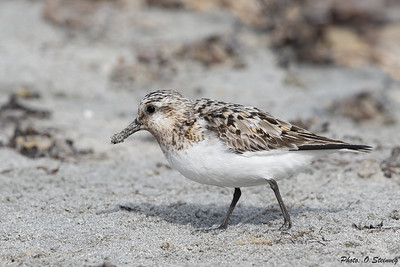
Identification:
A small, active sandpiper (7-8 inches), with a short, straight black bill and black legs.
Distinctive Markings:
In non-breeding plumage, they are pale gray with a white underside; in breeding season, they develop rust-colored patches.
Habitat:
Common on sandy beaches and shorelines, often seen at the water’s edge.
Behavior:
Sanderlings exhibit wave-chasing behavior, running along the shore to catch invertebrates as waves retreat. They rarely wade into the water, instead preferring the wet sand. Highly migratory, they breed in the Arctic and winter in Florida.

3. American Oystercatcher (Haematopus palliatus)
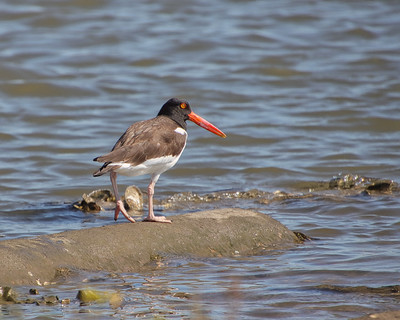
Identification:
A large shorebird (17-21 inches) with black-and-white plumage, long pink legs, and a thick, bright orange-red bill.
Distinctive Markings:
Bold black head, white underparts, and striking yellow eyes with a red eye-ring.
Habitat:
Coastal beaches, oyster beds, and mudflats.
Behavior:
Uses its powerful bill to pry open shellfish like oysters and clams. Often seen walking along shorelines, probing for food. Nests directly on sand, laying 2-4 eggs. During breeding season, they aggressively defend their territory.
Also Read : 14 Birds That Look Like a Peacock
4. Marbled Godwit (Limosa fedoa)
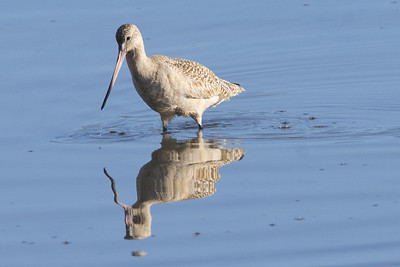
Identification:
A large shorebird (16-19 inches) with long bluish-gray legs and a slightly upturned, pinkish bill that darkens at the tip.
Distinctive Markings:
Cinnamon-colored plumage with dark barring on wings and back.
Habitat:
Mudflats, estuaries, and coastal marshes.
Behavior:
Uses its long bill to probe deep into wet sand and mud for invertebrates. Sweeps its bill side to side to locate prey. Migrates from breeding grounds in the northern Great Plains to winter in Florida.
5. Royal Tern (Thalasseus maximus)
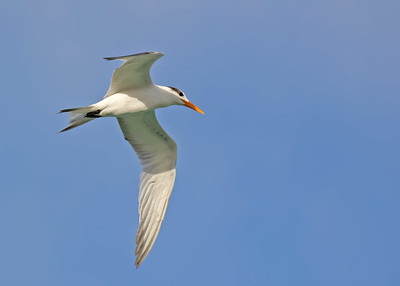
Identification:
The Royal Tern is a large seabird, measuring 18-21 inches in length with a wingspan of about 50 inches. It has a slender body, long pointed wings, and a sharp, slightly curved, bright orange bill. Its flight is elegant and buoyant, often seen gliding over coastal waters.
Distinctive Markings:
It has a gray back, white underside, and a black cap on its head that recedes in the non-breeding season, leaving only a black patch behind the eyes.
Habitat:
Royal Terns are found along coastal beaches, estuaries, and nearshore waters, rarely venturing far inland.
Behavior:
They hunt fish by plunge-diving into the water from midair, often in small groups. They nest in large, noisy colonies on sandy beaches, laying one or two eggs in a shallow scrape.
6. Ruddy Turnstone (Arenaria interpres)
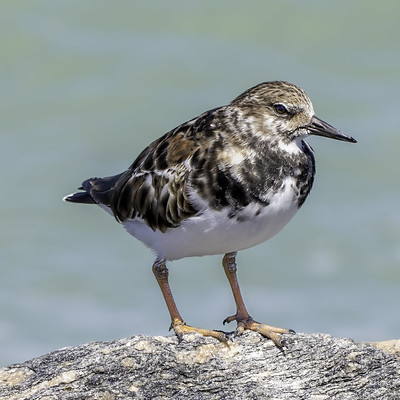
Identification:
The Ruddy Turnstone is a small, stocky shorebird measuring 8-10 inches in length with a short, slightly upturned black bill and bright orange legs. Its compact body and agile movements make it easily recognizable among other shorebirds.
Distinctive Markings:
During breeding season, it has striking harlequin-like plumage with a mix of black, white, and rich chestnut colors. In non-breeding plumage, it appears duller, with brownish-gray upperparts.
Habitat:
Found along rocky coastlines, sandy beaches, mudflats, and jetties, Ruddy Turnstones prefer areas with seaweed and debris where they can forage.
Behavior:
True to their name, they flip over stones, shells, and debris using their strong bills to uncover insects, crustaceans, and mollusks. They migrate from Arctic breeding grounds to Florida’s coasts in winter, often seen in small flocks.
7. Snowy Plover (Charadrius nivosus)
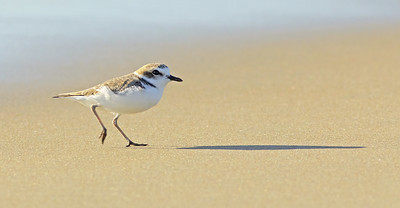
Identification:
The Snowy Plover is a tiny shorebird, measuring 5-7 inches in length, with a short, thin black bill and long, slender dark legs. It has a round, compact body and a short tail, making it well-adapted for running across sandy beaches.
Distinctive Markings:
Its pale sandy-gray upperparts blend perfectly with its coastal habitat, while its white underparts provide contrast. It has a thin black collar, black patches on the forehead and behind the eyes, and a small black bar on each side of the neck.
Habitat:
Snowy Plovers prefer sandy beaches, salt flats, and coastal dunes, often near tidal zones.
Behavior:
They forage for small insects and crustaceans by darting quickly across the sand. They nest directly on the ground, creating shallow scrapes in the sand, making them vulnerable to human disturbances and predators.
8. Whimbrel (Numenius phaeopus)
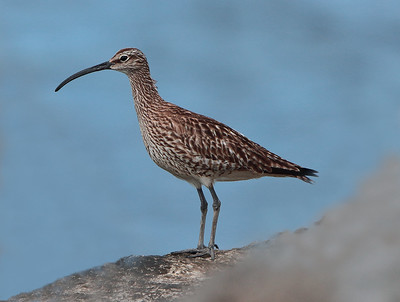
Identification:
The Whimbrel is a large shorebird, measuring 15-19 inches in length, with long, bluish-gray legs and a long, downward-curved bill. Its bill is perfectly adapted for probing deep into sand and mud to catch invertebrates.
Distinctive Markings:
It has brown streaked plumage that provides excellent camouflage in coastal habitats. A distinctive dark crown stripe separates two pale stripes running along the top of its head, helping differentiate it from other curlews.
Habitat:
Whimbrels inhabit mudflats, salt marshes, beaches, and tidal estuaries. They are most commonly seen during migration, as they travel between Arctic breeding grounds and wintering areas, including Florida.
Behavior:
They forage by probing for crabs, marine worms, and insects. Whimbrels are strong migratory birds, capable of flying thousands of miles nonstop between breeding and wintering grounds. Their high-pitched, whistling call is often heard in flight.
9. Least Sandpiper (Calidris minutilla)
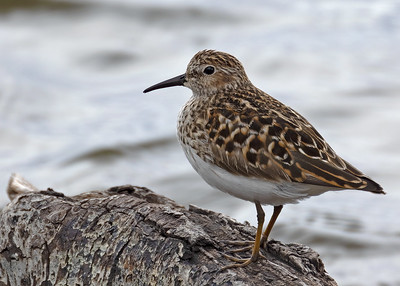
Identification:
The Least Sandpiper is the smallest shorebird, measuring only 5-6 inches in length, with a wingspan of about 10 inches. It has a compact body, short, thin, slightly decurved bill, and slender legs.
Distinctive Markings:
Its brownish upperparts contrast with a white belly. It can be distinguished from other sandpipers by its greenish-yellow legs (compared to the black legs of similar species). During breeding season, it has darker, more patterned plumage.
Habitat:
Found in mudflats, salt marshes, and freshwater wetlands, this sandpiper prefers wet, muddy areas where it can forage in shallow water.
Behavior:
Least Sandpipers forage by carefully picking at tiny invertebrates such as insects, crustaceans, and small mollusks. They migrate long distances from Arctic breeding grounds to Florida’s coasts and wetlands, often traveling in small flocks.
10. Killdeer (Charadrius vociferus)
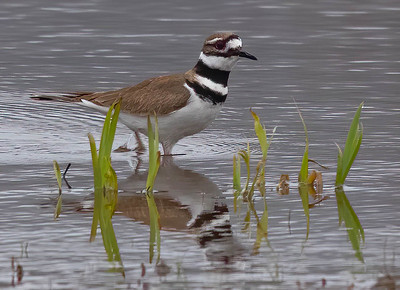
Identification:
The Killdeer is a medium-sized plover, measuring 8-11 inches in length, with a slender body, long legs, and a relatively short, straight black bill. It has a round head and large, dark eyes that enhance its alert appearance.
Distinctive Markings:
It is easily recognized by its brown upperparts, white underparts, and two distinct black bands across its chest. The face has a white forehead and a dark stripe that runs from the bill through the eye. Its long, rusty-orange rump is visible in flight.
Habitat:
Unlike many shorebirds, Killdeer inhabit a variety of open landscapes, including shorelines, gravel roads, fields, golf courses, and even urban areas.
Behavior:
Famous for its “broken-wing” distraction display, the Killdeer feigns injury to lure predators away from its nest. It has a loud, repetitive “kill-deer” call and actively runs while foraging for insects and small invertebrates.
11. Semipalmated Plover (Charadrius semipalmatus)
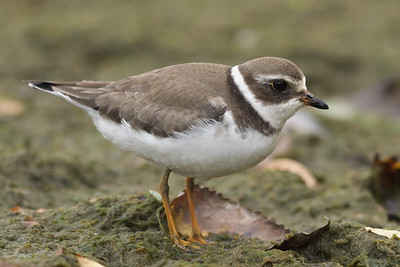
Identification:
The Semipalmated Plover is a small shorebird, measuring 6-7 inches in length, with a compact body, short neck, and a short, straight black bill with an orange base. It has relatively long wings and a rounded head, giving it a plump appearance.
Distinctive Markings:
It has brown upperparts and a white underside, with a single bold black band across its chest. It also features a white eyebrow stripe, orange legs, and a dark face mask. The term “semipalmated” refers to the partial webbing between its toes, which helps it walk on wet sand and mud.
Habitat:
Found along sandy beaches, mudflats, estuaries, and shorelines during migration and wintering periods.
Behavior:
It forages using a stop-and-go technique, running short distances before pecking at small invertebrates like crustaceans, worms, and insects. Often seen in mixed flocks with other small shorebirds.
12. Black-necked Stilt (Himantopus mexicanus)
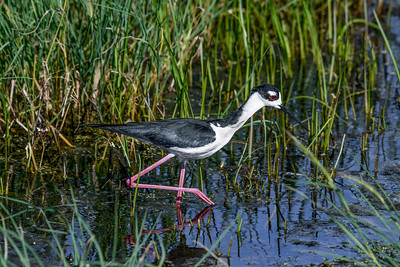
Identification:
The Black-necked Stilt is a striking shorebird, measuring 13-15 inches in length, with an extremely slender body, thin, straight black bill, and extraordinarily long pink legs—the longest legs in proportion to body size of any bird in North America.
Distinctive Markings:
It has contrasting black-and-white plumage, with a black back, wings, and head extending down the back of the neck. The underparts are pure white. Males have a glossy black sheen, while females appear slightly browner.
Habitat:
Prefers shallow wetlands, salt flats, estuaries, and coastal lagoons where water is shallow enough for wading.
Behavior:
Black-necked Stilts wade through shallow water, picking small fish, insects, and crustaceans from the surface. They are highly vocal and give sharp, yapping calls when disturbed. During breeding, they form loose colonies and aggressively defend their nests, often engaging in aerial displays to ward off predators.
13. Greater Yellowlegs (Tringa melanoleuca)
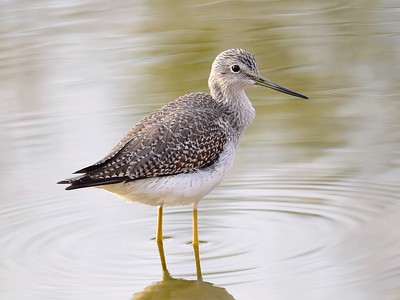
Identification:
The Greater Yellowlegs is a tall, slender shorebird, measuring 11-14 inches in length, with long, bright yellow legs and a slightly upturned, straight bill that is longer than its head. It has a sleek body and a graceful, upright posture.
Distinctive Markings:
Its plumage is speckled gray and brown on the upperparts, with a white belly. During breeding season, it has more distinct streaking on the neck and breast. In flight, it displays a white rump and a dark-barred tail.
Habitat:
Common in mudflats, salt marshes, estuaries, shallow wetlands, and coastal shorelines.
Behavior:
Greater Yellowlegs actively forage in shallow water, often stirring up prey with their feet before striking. They eat small fish, crustaceans, and insects. They are known for their loud, piercing calls and tend to be more solitary than Lesser Yellowlegs, though they sometimes mix in small flocks.
14. Lesser Yellowlegs (Tringa flavipes)
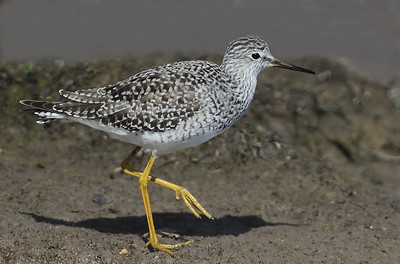
Identification:
The Lesser Yellowlegs is a medium-sized shorebird, measuring 10-11 inches in length, with long, bright yellow legs and a straight, slender black bill that is about the same length as its head. It has an elegant, upright stance and a sleek body.
Distinctive Markings:
It has gray-brown upperparts speckled with white and a white belly. During breeding season, its plumage becomes more heavily streaked on the neck and breast. In flight, it shows a white rump and barred tail. It closely resembles the Greater Yellowlegs but is smaller with a proportionally shorter, straighter bill.
Habitat:
Found in wetlands, mudflats, estuaries, salt marshes, and shallow ponds.
Behavior:
Lesser Yellowlegs are active foragers, wading in shallow water and picking up small fish, insects, and crustaceans. They are social, often found in small flocks, and their soft “tu-tu” call helps distinguish them from the louder Greater Yellowlegs.
Conclusion
Shorebirds of Florida offer birdwatchers a chance to witness an array of fascinating species year-round. By learning to recognize these birds by their size, plumage, behavior, and habitat, you can gain a deeper appreciation for the coastal and wetland ecosystems that support them. Whether you’re strolling along the beach or exploring a marsh, keep an eye out for these incredible shorebirds and their unique adaptations.

Welcome to World Birds Life, where the wonder of birds takes center stage. My name is Lexi, and I’m passionate about helping you discover the beauty and joy that birds bring into our lives.

